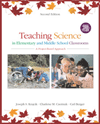 |  Teaching Children Science: A Project-Based Approach, 2/e Joe Krajcik,
University of Michigan - Ann Arbor
Charlene Czerniak,
University of Toledo
Carl Berger,
University of Michigan - Ann Arbor
Why and How Should I Teach Science to Children?
Chapter Summary- Project-based science stands apart from other forms of science teaching because it situates the learning of science in questions that children find meaningful and relevant to their lives.
- Each chapter starts with several scenarios that are designed to help you envision various classroom scenes that we will discuss.
- Throughout the text, questions encourage you to stop and think about ideas before you continue to read.
- There are activities throughout each chapter that are designed to help you construct meaning from what you're reading.
- When you complete these activities, you will have portfolio products (or artifacts).
- Throughout the book, we discuss how technology can be used to teach science.
- One way to examine features of project-based science is to contrast it with
- Read about science.
- Direct instruction.
- Process science teaching.
- Project-based science is sensitive to the varied needs of diverse students with respect to culture, race, and gender.
- Driving questions serve to organize and guide instructional tasks and activities.
- All driving questions should be meaningful and important to students.
- Students engage in investigations to answer their questions.
- Communities of students, teachers, and others collaborate on the question or problem.
- Students use technology to investigate, develop artifacts, collaborate, access information, and actively construct knowledge.
- A series of artifacts or products document what students have learned.
- Scientists test these hypotheses by collecting data, analyzing data, making conclusions, and communicating findings.
- To be classified as scientific, the observations, measurements, and conclusions made by one group of scientists must be verified by others.
- The understanding that results from science is tentative and changes with new observations.
- Science study helps students
- Acquire knowledge and skills that will be useful throughout their lives.
- Develop positive attitudes that foster responsibility for one's actions.
- Guide students in understanding real life issues.
- Science affects every aspect of our lives.
- The study of science helps develop scientifically literate citizens.
- The elementary and middle grades are also important years for developing curiosity and interest in science.
- Science education goals advocate science literacy for all students and set forth recommendations about learning, curriculum, and teaching
- Students should explore broad concepts or "big ideas" instead of isolated facts or skills.
- All students should learn to think critically, solve problems, and make decisions.
- Children should construct meaning from experiences with concrete materials rather than passively.
- Students should learn how to apply science and technology to everyday life.
- Science should foster the development of students' natural curiosity, creativity, and interest.
- Science instruction should foster the development of scientific attitudes.
- Less content should be covered in the curriculum.
- Science should be portrayed to students as interdisciplinary, connected to other fields of study.
- The teacher serves as a guide in the classroom, encouraging student exploration and learning rather than acting as an authoritative presenter of knowledge.
- The content of science should be taught as a process, involving investigation and answering questions.
- Science instruction should encourage students to challenge and debate ideas.
- Science instruction should build upon children's prior experiences and knowledge.
- Project-based science is a dynamic teaching approach that helps educators meet the goals and standards set by national reform efforts.
|
|



 2003 McGraw-Hill Higher Education
2003 McGraw-Hill Higher Education